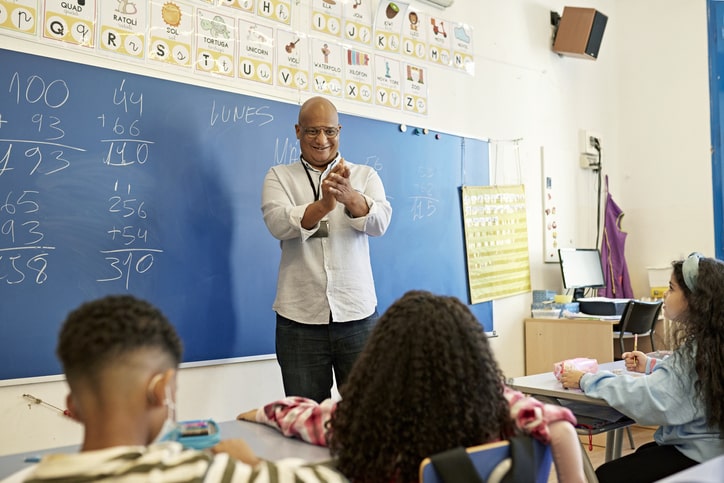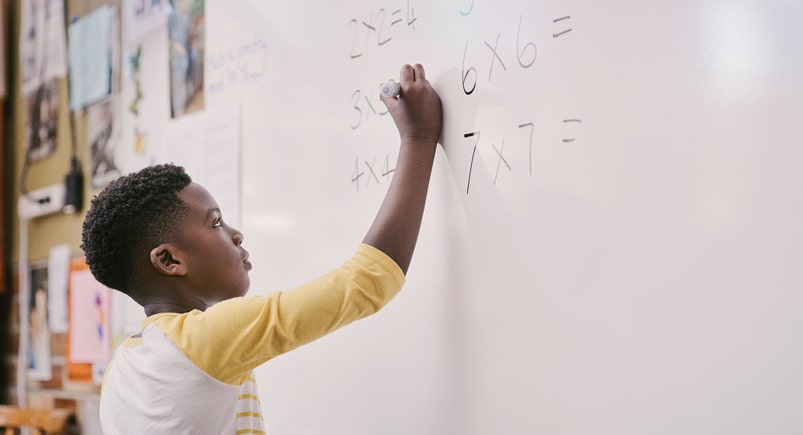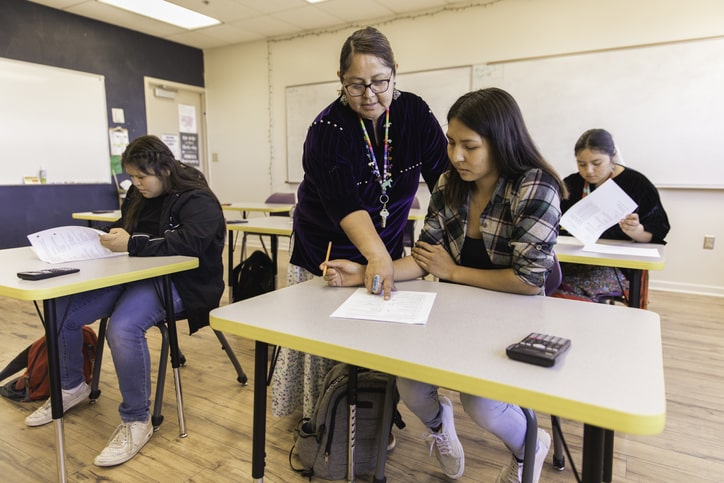Pattern analysis is a critical 21st Century skill
Pattern problem solving is a fundamental mathematical strategy that involves the identification of repeated sequences or elements to solve complex problems. Use this resource to enhance your lesson with the included guidelines and examples that will help students learn how to find patterns.Need more tips and tricks for teaching math? You can find them in our math resources center.
Pattern problem solving
In this article, we’ll delve into the concept of pattern problem solving, a fundamental mathematical strategy that involves the identification of repeated sequences or elements to solve complex problems.
This method is instrumental in enhancing logical thinking and mathematical comprehension among students. Let's explore how this works, why it's important, and how to teach this critical skill effectively.

What is pattern problem solving?
Pattern problem solving is a mathematical strategy in which students look for patterns in data to solve a problem. To find a pattern, students search for repeated items, numbers, or series of events.
The following problem can be solved by finding the pattern:
There are 1000 lockers in a high school with 1000 students. The first student opens all 1000 lockers; next, the second student closes lockers 2, 4, 6, 8, 10, and so on up to locker 1000; the third student changes the state (opens lockers that are closed, closes lockers that are open) of lockers 3, 6, 9, 12, 15, and so on; the fourth student changes the state of lockers 4, 8, 12, 16, and so on. This continues until every student has had a turn. How many lockers will be open at the end?
For the answer, visit The Locker Problem from the Math Doctors
Why is pattern problem solving important?
Pattern problem solving is an important strategy for students as it encourages them to observe and understand patterns in data, which is a critical aspect of mathematical and logical thinking.
This strategy allows students to predict future data points or behaviors based on existing patterns. It helps students understand the inherent structure of data sets and mathematical problems, making them easier to solve.
Pattern recognition also aids in the understanding of multiplication facts, for example, recognizing that 4 x 7 is the same as 7 x 4. Overall, pattern problem solving fosters analytical thinking, problem-solving skills, and a deeper understanding of mathematics.

How to teach students to find the pattern in a math problem (using an example)
In the upcoming section, we will break down the steps on how to find a pattern in a math problem effectively. We will use a practical example to illustrate each step and provide helpful teaching tips throughout the process.
The goal is to offer a clear and comprehensible guide for educators teaching students about pattern problem solving in math.
Sample question: If you build a four-sided pyramid using basketballs and don't count the bottom as a side, how many balls will there be in a pyramid that has six layers?
Helpful teaching tip: Use cooperative learning groups to find solutions to the above problem. Cooperative learning groups help students verbalize their thinking, brainstorm ideas, discuss options, and justify their positions. After finding a solution, each group can present it to the class, explaining how they reached their solution and why they think it is correct. Or, students can explain their solutions in writing, and the teacher can display the solutions. Then students can circulate around the room to read each group's solution.
1. Ensure students understand the problem
Demonstrate that the first step to solving a problem is understanding it. This involves identifying the key pieces of information needed to find the answer. This may require students to read the problem several times or put the problem into their own words.
Sometimes you can solve a problem simply through pattern recognition, but more often you must extend the pattern to find the solution. Making a number table will help you see the pattern more clearly.
In this problem, students understand:
The top layer will have one basketball. I need to find how many balls there will be in each layer of a pyramid, from the first to the sixth. I need to find how many basketballs will be in the entire pyramid.
2. Choose a pattern problem solving strategy
To successfully find a pattern, you need to be sure that the pattern will continue.
Have students give reasons why they think the pattern is predictable and not based on probability. Problems that are solved most easily by finding a pattern include those that ask students to extend a sequence of numbers or to make a prediction based on data.
In this problem, students may also choose to make a table or draw a picture to organize and represent their thinking.
3. Solve the problem
Start with the top layer of the pyramid, one basketball. Determine how many balls must be under that ball to make the next layer or a pyramid. Let students use manipulatives if needed— they can use manipulatives of any kind, from coins to cubes to golf balls. Let students also draw pictures to help solve the problem, if needed.
If your students are in groups, you may want to have each group use a different manipulative and then compare their solutions. This will help you understand if different manipulatives affect the solution.
Helpful teaching tip: If students are younger, solve this problem with only three layers.
If it helps to visualize the pyramid, use manipulatives to create the third layer. Record the number and look for a pattern. The second layer adds 3 basketballs and the next adds 5 basketballs. Each time you add a new layer, the number of basketballs needed to create that layer increases by 2.
| Layer | Balls Added | Balls in This Layer |
| 1 (top) | 1 | 1 |
| 2 | 3 | 4 (1 + 3 = 4) |
| 3 | 5 | 9 (4 + 5 = 9) |
| 4 | 7 | 16 (9 + 7 = 16) |
| 5 | 9 | 25 (16 + 9 = 25) |
| 6 | 11 | 36 (25 + 11 = 36) |
1
1 + 3 = 4
4 + 5 = 9
Continue until six layers are recorded. Once a pattern is found, students might not need to use manipulatives. 9 + 7 = 16
16 + 9 = 25
25 + 11 = 36
Then add the basketballs used to make all six layers.
The answer is 91 balls.
Look at the list to see if there is another pattern. The number of balls used in each level is the square of the layer number. So the 10th layer would have 10 x 10 = 100 balls.
4. Check your students' answers
Read the problem again to be sure the question was answered:
Yes, I found the total number of basketballs in the six-layer pyramid.
Also check the math to be sure it’s correct:
1 + 4 + 9 + 16 + 25 +36 = 91
Determine if the best strategy was chosen for this problem, or if there was another way to solve the problem:
Finding a pattern was a good way to solve this problem because the pattern was predictable.
5. Explain
Students should be able to explain the process they went through to find their answers. Students must be able to talk or write about their thinking. Demonstrate how to write a paragraph describing the steps they took and the decisions they made throughout.
I started with the first layer. I used blocks to make the pyramid and made a list of the number of blocks I used. Then I created a table to record the number of balls in each layer.
I made four layers, then saw a pattern. I saw that or each layer, the number of balls used was the number of the layer multiplied by itself.
I finished the pattern without the blocks, by multiplying the number of balls that would be in layers 5 and 6.
Then I added up each layer.
1 + 4 + 9 + 16 + 25 +36 = 91.
I got a total of 91 basketballs
How can you stretch this pattern problem solving strategy?

Math problems can be simple, with few criteria needed to solve them, or they can be multidimensional, requiring charts or tables to organize students' thinking and to record patterns.
In using patterns, it is important for students to find out if the pattern will continue predictably. Have students determine if there is a reason for the pattern to continue, and be sure students use logic when finding patterns to solve problems.
- For example, if it rains on Sunday, snows on Monday, rains on Tuesday, and snows on Wednesday, will it rain on Thursday?
- Another example: If Lauren won the first and third game of chess, and Walter won the second and fourth game, who will win the fifth game?
- Another example: If a plant grew 13 centimeters in the first week and 10 centimeters in the second week, how many centimeters will it grow in the third week?
Because these are questions of probability or nature, be sure students understand why patterns can't be used to find these answers.




